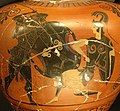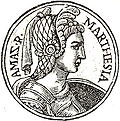List of 999 women of the Heritage Floor / Amazons
This list describes the place settings for the Amazons on the table of Judy Chicago's art installation The Dinner Party . It is part of the list of 999 women on the Heritage Floor who are assigned to the respective place settings on the table. The names of the 999 women are on the tiles of the Heritage Floor, which is arranged below the table and belongs to the art installation.
description
The installation consists of a three-sided table, each with 13 historical or mythological personalities, thus a total of 39 people, from prehistory to the women's rights movement . These people were assigned a place setting at the table, consisting of an individually designed table runner, an individually designed plate, a goblet, knife, fork, spoon and serviette. The first page of the table is devoted to prehistory up to the Roman Empire , the second to Christianization up to the Reformation and the third from the American Revolution to the women's movement. Each place setting on the table is assigned additional personalities who have received an entry on the tiles of the Heritage Floor, which occupies the space under the table and the center of the space between the sides of the table. This list captures the personalities who are assigned to the Amazon's table setting. Your seat is on the first side of the table.
Hints
In addition to the names as they are used in German transcription or in scientific usage, the list shows the spelling chosen by Judy Chicago on the tiles.
The information on women who do not yet have an article in the German-language Wikipedia is referenced by the individual references listed under comments . If individual information in the table is not referenced via the main article, additional individual references are given at the relevant point. If there are any discrepancies between the information provided in Wikipedia articles and the descriptions of the work of art on the Brooklyn Museum website , this will also be indicated under Comments.
Place setting for the Amazons
According to Greek mythology , the Amazons were peoples in which women were warriors and ruling queens. Spatially, they are said to have lived on the Black Sea , in the Caucasus , in Northern Anatolia, but also in Caria , Lycia and Libya . Some Amazons were also founders of important cities. First mentions are found in the writings of Homer .
In the art installation The Dinner Party , the Amazons represent the tradition of powerful female warriors and the value of women's communities. The Amazons are symbolically represented in the table setting. The table setting represents the Amazons as warriors and as worshipers of the gods. The color palette with which it is designed consists of black, red and white, as these colors are traditionally used in artistic representation for Amazons.
The plate bears the image of breasts, which are covered with gold and silver like a breastplate, which women warriors wore in battle. There are also images of two double axes , a white egg, a red crescent moon and a black stone, all of which are associated with the Amazons. Double axes were an element of worshiping the gods in the Minoan period .
The place runner picks up the symbols used on the plate. The white egg, the red half moons and the double axes as well as the breastplate are depicted on it. A triangle as a symbol for the divine and feminine forms the basis for the egg and the crescents. The snakeskin used in front of the front of the runner was a material that Amazons wore in battle. The laces on the sides take up the ties of the war boots that can be seen on the Pergamon Altar . Both the titanium leaves of the axes and the lacing are tied with French knots made from copper fibers taken from the rivets on the boots of the Amazons. The image of the ax is repeated in the luminous capital letter "A" on the front of the runner.
| Surname | Spelling on the tile | Date of birth | cultural spatial assignment | Remarks | image |
|---|---|---|---|---|---|
| Aegea | Egee | N / A | Greek mythology | In Greek mythology she is presented as the queen of the Amazons and is considered the eponymous heroine of the Aegean Sea , in which she is said to have found her death.
In the description accompanying the work of art, she is described as the Queen of the Amazons, who moved from Libya to Asia Minor to fight at Troy . |
|
| Antiope | Antiope | N / A | Greek mythology | Part of the Theseus and Heracles myths.
She was included in the list as the warrior queen of the Amazons, the sister of Queen Hippolyte and daughter of Ares , god of war. |

|
| Eurypyle | Eurpyle | N / A | Mesopotamia | According to the description in the work of art, the Nubian Amazon queen Eurypyle has a legend around 1760 BC. Led an all-female expedition against Nineveh and Babylon . | |
| Hiera | Hiera | N / A | Greek mythology | Hiera, the wife of Telephos , led the Mysian women on horseback when the Hellenes invaded the Trojan War . | |
| Hippolyte | Hippolyte | N / A | Greek mythology | Daughter of the Amazon queen Otrere and the Olympic god of war Ares . In the Theseus - and in the Heracles - myth she is herself queen of the Amazons . |

|
| Lampeto | Lampedo | N / A | Greek mythology | Amazons queen, mentioned in Roman historiography, ruled with her sister Marpesia. The two are said to have been the daughters of Mars . |

|
| Marpesia | Martesia | N / A | Greek mythology | The amazon queen, mentioned in Roman historiography, ruled with her sisters Hippo and Lampeto. Through a series of military conquests, they expanded the realm of the Amazons. She was killed in battle and succeeded by her daughters Sinope and Orithya. |

|
| Medusa | Medusa | N / A | Greek mythology | In Greek mythology, a Gorgon , daughter of the sea deities Phorkys and Keto , sister of Stheno and Euryale . After Athena surprised her with Poseidon while making love, she was transformed into a monster, the sight of which turned everyone to stone. Perseus beheaded her, and Pegasus and Chrysaor sprang from her body . |

|
| Myrina | Myrine | N / A | Greek mythology | North African Amazon queen, led a military expedition in Libya, defeated the Atlanteans, formed an alliance with the ruler of Egypt and conquered other cities and islands, including Lesbos. The rulers who succeeded her took the title of Myrine as an honorary title to honor her for her efforts to expand the kingdom. | |
| Orithyia | Orinthya | N / A | Greek mythology | Queen of the Amazons, daughter of Marpesia. Ruled with her sisters Antiope and Hippolyte. She led the Amazons into battle against the Athenians and formed an alliance with the Scythians to use Scythian slaves in Athens for their cause. The conflict was sparked by Heracles , who stole Queen Hippolyte's magical belt. |

|
| Penthesilea | Penthesilia | N / A | Greek mythology | Daughter of the Amazon queen Otrere and the Olympic god of war Ares . She accidentally killed her sister Hippolyte in a hunting accident, came to the aid of the hard-pressed Trojans with her warriors, and was defeated by Achilles . |

|
| Thalestris | Thalestris | N / A | Greek mythology | Last Amazon queen to be mentioned by name. It is said to be in 330 BC. BC met the Macedonian king Alexander the great during his campaign in Asia. Modern researchers consider her a made-up person.
In the artwork it is described that her concern should have been to breed children with extraordinary courage and intelligence and so she brought 300 Amazons to Alexander the Great. The result is unknown. |

|
- Individual evidence
- ↑ Brooklyn Museum: Amazon. In: brooklynmuseum.org. Retrieved September 28, 2019 .
- ↑ Brooklyn Museum: Egee. In: brooklynmuseum.org. Retrieved September 22, 2019 .
- ↑ Brooklyn Museum: Antiope. In: brooklynmuseum.org. Retrieved September 24, 2019 .
- ↑ Brooklyn Museum: Eurpyle. In: brooklynmuseum.org. Retrieved September 24, 2019 .
- ↑ Brooklyn Museum: Hiera. In: brooklynmuseum.org. Retrieved September 28, 2019 .
- ↑ Brooklyn Museum: Martesia. In: brooklynmuseum.org. Retrieved September 28, 2019 .
- ↑ Brooklyn Museum: Medusa. In: brooklynmuseum.org. Retrieved September 28, 2019 .
- ↑ Brooklyn Museum: Myrine. In: brooklynmuseum.org. Retrieved September 28, 2019 .
- ↑ Brooklyn Museum: Orinthya. In: brooklynmuseum.org. Retrieved September 28, 2019 .
- ↑ Brooklyn Museum: Penthesilia. In: brooklynmuseum.org. Retrieved September 28, 2019 .
- ↑ Brooklyn Museum: Thalestris. In: brooklynmuseum.org. Retrieved September 28, 2019 .
Web links
- Brooklyn Museum, Amzon
- The Dinner Party on the website of Through the Flower , Judy Chicago's non-profit organization
